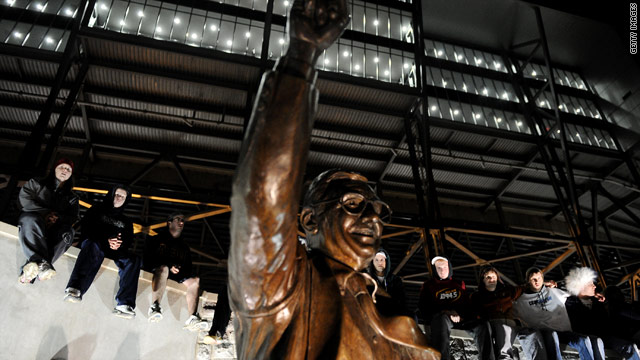By Dan Gilgoff
CNN
November 10, 2011
http://religion.blogs.cnn.com/2011/11/10/seeming-parallels-abound-in-penn-state-catholic-church-abuse-scandals/
 |
| The statute of Penn State football coach Joe Paterno, who was fired Wednesday, in State College, Pennsylvania. |
Both are managed by male dominated-hierarchies. Both are revered by millions of people. And both allegedly dealt with accusations of sexual abuse of children internally, without going to law enforcement authorities.
To many victims’ advocates, commentators and others, the parallels between this week’s allegations about how Penn State dealt with reports of sex abuse and decade-old revelations about sex abuse in the Roman Catholic Church are uncanny.
“It is really a striking and almost identical factual pattern that has emerged in the Catholic Church cases and at Penn State,” says Jeffrey Anderson, a lawyer who has represented hundreds of American abuse victims in lawsuits against the Catholic Church.
Penn State: A campus divided
“The only difference is that two people have been fired at Penn State who were in revered positions,” says Anderson. “That’s in contrast to every diocese in the U.S where a cover-up has been revealed.
“Not one bishop, archbishop or cardinal has been fired or disciplined.”
Anderson is referring to Wednesday’s firing of Penn State President Graham Spanier and head football coach Joe Paterno, days after former assistant football coach Jerry Sandusky was charged with abusing eight boys, including in a Penn State locker room.
My Take: Paterno's unfulfilled ethical obligations
Two top Penn State university officials who were allegedly told about the abuse and declined to notify authorities have been charged with perjury and with failure to report suspected abuse.
Anderson says both the alleged abuse by a Penn State coach and the institution’s apparent response mirrors the abuse scandal in the Catholic church.
“In both cases, very trusted and revered male offenders used their positions and their care, cunning and trust they enjoy not only to access the victim but to keep those around him from speaking out,” says Anderson.
Prosecutors have alleged that Sandusky used a charity he founded for troubled youth to help lure victims, allegedly engaged in fondling, oral sex and anal sex with young boys over more than 10 years.
Photos: Responding to scandal
Many of those outraged by the allegations against Penn State, including that Paterno had reportedly been told about the abuse but declined to notify authorities, have pointed a finger at what they say was the school’s and its football program’s commitment to maintaining a sterling public image, drawing parallels to the church.
“Both institutions are big and powerful and hierarchical and have very carefully crafted public reputations that they value,” says David Clohessy, national director of SNAP, the Survivors Network of those Abused by Priests. “There’s an obsession with an institution’s image over children’s safety.”
Clohessy says news of the Penn State scandal has triggered a wave of calls and e-mails to him from victims who say the new revelations evoke their experiences with priest abuse.
He and others allege that an aura of righteousness surrounding Penn State football, an object of worship in State College, Pennsylvania, and the Catholic Church helped fortify them against accusations of abuse in their midst.
“When we idolize any institution or individual, it’s unhealthy,” says Clohessy. “We almost invite them to act like they're above the law.”
Share your thoughts through iReport
Anderson says a related parallel between the Penn State and Catholic Church scandals is the existence of hierarchies that apparently allowed personnel to report abuse allegations up a chain of command without higher-ups taking decisive action.
“It’s not because they’re bad men or want kids to be harmed,” said Anderson, speculating about the motives of top officials at Penn State and the church who allegedly kept quiet about abuse allegations, “but because they want to preserve the reputation of the institutions.”
Anderson is licensed to practice in Pennsylvania but would not say whether he is representing any of Sandusky's alleged victims, saying he would want to respect their confidentiality if he was.
The U.S. Conference of Catholic Bishops, which represents the American Roman Catholic hierarchy, declined to respond to a request for comment on Thursday.
Many abuse victims applauded Penn State for firing top officials and criticized the Roman Catholic Church for not taking similarly dramatic action.
“What happened at Penn State tonight is a lesson to officials of the Catholic Church,” said Robert M. Hoatson, who leads a New Jersey group that assists abuse victims, in a statement after Wednesday night’s firings at Penn State. “The only just solution to the clergy abuse scandal of the Catholic Church is the wholesale removal of bishops.”
Church experts say Penn State’s decision to fire its president and its football coach reflect more of a top-down approach to personnel than in the Catholic Church, where issues are expected to be resolved locally, at the diocesan level.
“The American model of accountability drove the decision on Paterno, which is that ‘accountability’ means losing your job,” says John Allen, CNN’s chief Vatican analyst. “Whereas the Roman model tends to shape decisions on bishops, where ‘accountability’ means staying put and cleaning up your own mess.”
Still, some Vatican watchers say the church sex abuse crisis has helped shaped Penn State’s reaction to last weekend’s indictment.
“The Catholic Church's experience with this has raised public awareness, which probably helps to explain the swift reaction in this case,” says Francis X. Rocca, who covers the Vatican for the Religion News Service.
“It is a lot harder than it was 10 years ago,” he says, “for administrators to argue that they didn't understand the gravity of the problem or thought it could be dealt with internally.”
Any original material on these pages is copyright © BishopAccountability.org 2004. Reproduce freely with attribution.